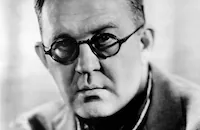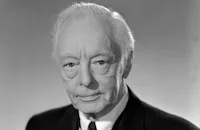December 7th

Brief Synopsis
Cast & Crew
John Ford
Walter Huston
Harry Davenport
Dana Andrews
George O'brien
Paul Hurst
Film Details
Technical Specs
Synopsis
After the Japanese bombing of Pearl Harbor, the U.S. fights to survive the early days of World War II.
Videos
Movie Clip



Hosted Intro
Film Details
Technical Specs
Award Wins
Best Documentary Short Subject
Articles
December 7th
This was all occurring mere weeks after the assault on Pearl Harbor. There was plenty of finger pointing and congressional investigations back in Washington and the mission and command structure of the Field Photographic unit was still not completely defined. Donovan wanted to put the lens on the military mistakes while the Navy needed something to show how they were rebuilding and recovering from the devastating attack. Toland and Engel had their own vision and turned the short report into an ambitious feature with extended fictionalized sequences featuring Hollywood actors and extensive recreations of the attack with army personnel at Pearl Harbor and the adjacent Hickam Air Force Base and miniatures filmed in Hollywood by Ray Kellogg. While some footage of the actual attacked had been filmed by Navy personnel, there was too little to provide a full portrait on film. Kellogg's special effects ended up being mistaken for actual combat footage and was used in newsreels and movies for years.
Though Ford was dubious of the direction they were going, he did not stop their work or even step in to redirect it. Rather, he took over shooting scenes of the rebuilding efforts and helmed some of the recreations until orders sent him on his own missions, including an assignment to Midway, where he shot what would become The Battle of Midway (1942). Ford had advised Toland to work quietly around the military and not draw attention to what he was doing, but Toland ignored his advice. He stepped on toes during the production and ignored military protocol and respect for rank. He was, in the words Ford biographer and grandson Dan Ford, "brash and arrogant, operating with little regard for political consequences."
By the time Ford checked back on their progress, the project was overdue, overlong, and the most controversial film to come out of his unit. Toland and Engel offered more editorializing than reporting in their feature-length production. They built it around a didactic and xenophobic debate between U.S. (Walter Huston traditional Uncle Sam get-up) and Mr. C (Harry Davenport, playing Uncle Sam's conscience) over the torn allegiances of Japanese-Americans and included scenes of an American soldier, a casualty of the attack played by Dana Andrews, looking down from heaven. One Admiral was upset at the way the film criticized the Navy's lack of preparedness. The Joint Chiefs of Staff thought it would undermine morale. The government was worried that its portrait of Japanese-Americans as potential spies could incite violence. Roosevelt issued a directive that all films produced by the Field Photo unit would be subject to censorship by the War Department. The autonomy that Ford had earned with The Battle of Midway was taken away.
The film was permanently shelved until Ford and his editor, Robert Parrish, cut it down to a more acceptable version. They removed the debates between U.S. and Mr. C, scenes that presented the Japanese of Hawaii as a race of potential traitors, and the finale with the dead soldier in heaven reminiscing with other veterans of American wars. Ford brought in screenwriters Frank Wead and James Kevin McGuinness to write new narration and softened the critique of the Navy's failures. The history and analysis was gone. Ford concentrated on the battle and the recovery, mourning the soldiers who were lost and then shifting into a portrait of the rebuilding effort. It was shortened from 83 minutes to just over half an hour and, while still kept out of general release, this version was shown to servicemen and munitions workers in 1943.
It was Ford's abbreviated cut that won the Academy Award for Documentary Short Subject in 1943, his fourth in four years. The full-length version was unseen for decades but preserved in the National Archives at Ford's request and ultimately declassified and released on home video. Now both versions are available to audiences. It makes for a fascinating contrast.
Sources:
Print The Legend, Scott Eyman. Simon & Schuster, 1999.
Pappy: The Life of John Ford, Dan Ford. Prentice Hall, 1979.
John Ford: The Man and His Films, Tag Gallagher. University of California Press, 1986.
Five Came Back, Mark Harris. The Penguin Press, 2014.
Searching For John Ford, Joseph McBride. St. Martin's Press, 2001.
IMBd
By Sean Axmaker

December 7th
December 7th - THE FULLY RESTORED VERSION OF DECEMBER 7th
Utilizing stock military footage of Pearl Harbor, December 7th departs from the typical documentary form to present a narrative framing device featuring Walter Huston as a character representing Uncle Sam, Harry Davenport as a folksy representation of "conscience" called Mr. C, and Dana Andrews as the ghost of an American soldier. The story opens on December 6, 1941, the day before the attack, with Uncle Sam and Mr. C carrying on a discussion about the history of Hawaii and the country's war preparations. One of the approaches taken by co-directors John Ford and Gregg Toland was to paint the Japanese-American citizens of Hawaii (37 percent of the population, according to the film) as potential traitors, fifth-columnists spying on their "American" employers for information to hustle back to the "homeland." When it was screened for military brass, there was alarm and disapproval. One officer said "the proportion of the picture's time and the attention given to the local Japanese problem is unwarranted when compared to the overall significance of the December 7th attack." The real issue, however, seemed to be the portrayal of America's readiness. Admiral Stark, commander of the Naval Forces in Europe, commented, "This picture leaves the distinct impression that the Navy was not on the job, and this is not true... I am not concerned with minor inaccuracies, but great harm will be done and sleeping dogs awakened if the picture is released as it now stands." To make matters worse, President Franklin D. Roosevelt issued a directive saying all future Field Photo material must be submitted for censorship before use, in the interest of preventing injury to morale.
To save the film and please the government, Ford and editor Robert Parrish went into the editing room and cut the framing device, chopping the picture down to 34 minutes and concentrating largely on the clean-up and preparedness efforts that followed. Toland had made a feature movie about America's worst military disaster; from it, Ford crafted a short subject about the country's quick recovery. It was this shorter version that was released and won the Oscar for Best Documentary.
Now you can see both versions on he DVD edition of December 7th plus a wealth of bonus material including full commentary by four Pearl Harbor survivors, Universal and Movietone News stories, Frank Capra's 62 minute documentary, Know Your Enemy: Japan, and English subtitles for the deaf and hearing impaired. For more information about December 7th, you can visit VCI Entertainment. To order the DVD or video, you can call 800-331-4077. Turner Classic Movies will also be showing the uncensored version of December 7th on Sunday, September 9 at 6:00 am ET.
If you are a World War II buff, you'll also be interested in these other new releases from VC! Entertainment and Kit Parker Films:
Combat Camera: The Pacific - original uncensored newsreels from Movietone News, Universal Newsreel Pathe News and the U.S. Navy, digitally restored. Some of the material includes The Fleet That Came to Stay, directed by Budd Boetticher, footage of Japan's surrender, Battle of Iwo Jima, Midway and Coral Sea Battles, and bonus shorts like This Could Be America.
The Colors of War: The Pacific is another exceptional DVD and it includes the documentaries Report from the Aleutians, directed by John Huston, The Battle of Midway, directed by John Ford, and several others plus a poster gallery and an interview with Joe Rosenthal, the man who photographed the flag raising on Iwo Jima's Mt. Suribachi. Visit VCI Entertainment for more information.




















